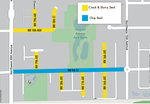

Now is a good time for Battle Ground residents to see their $20 Transportation Benefit District vehicle tab fee at work.
Tab fee-funded street maintenance and preservation projects are underway around Battle Ground and will likely last into fall.
Around $240,000 is collected from Battle Ground drivers each year through the tab fees, all of which goes toward transportation infrastructure improvements within the city.
The Transportation Benefit District tab fee began in July 2015, and the city reports that not including this year’s projects, the fees have funded, among other things, over 7 miles of road maintenance and preservation and 23 miles of lane striping.
This year, the projects will see the northwest quadrant of the city receive crack, slurry and chip sealing of streets; extensive pothole repairs around the city; and “mill and fill” on the north section of the South Parkway Improvement Project.
“The crack, slurry, and chip sealing processes protect streets from damaging water intrusion that would otherwise lead to potholes and eventual failure of the roadway,” city staff said.
Crews began applying asphalt rubber sealant to cracks in the streets last week.
The slurry seal will likely begin this week or next and will consist of an oil mixture being applied on a street from curb-to-curb.
Chip sealing is scheduled to get underway in September. It is similar to slurry sealing, but rocks are added to the ingredient that city staff says will create a stronger structural integrity.
The city will leverage an estimated $8,800 of Transportation Benefit District dollars to receive a $50,000 pothole-specific grant.
The grant was offered by the state's Transportation Improvement Board after a number of potholes were left in the wake of last winter’s harsh conditions.
Transportation Benefit District fees will also be put to work as the South Parkway Improvement Project trudges north.
To land a $366,000 grant for mill and fill — a process where a road is milled away and excavated where needed, followed by a new layer of asphalt — and Americans with Disabilities upgrades between Rasmussen and Main Street, the city leveraged the required $65,000.
“The city recognizes that many more streets in the city are in need of maintenance and repair,” staff said in a press release. “The usable life of a paved street, very much like a car or household appliance, is dependent on when and how it was constructed, how much it is used, its exposure to the elements, and preventive maintenance. The crack and slurry sealing maintenance process, while least costly, would not be the appropriate method to repair other streets. Some streets necessitate more expensive methods, ranging from chip sealing or a mill and fill process, to complete reconstruction … Through a comprehensive assessment of city streets, engineers determine the most appropriate and cost-effective method of maintenance and/or repair and the best use of annual Transportation Benefit District revenue. The city will continue to seek opportunities such as utilizing Transportation Benefit District revenue for grant matches, to leverage and enhance the taxpayer's investment.”